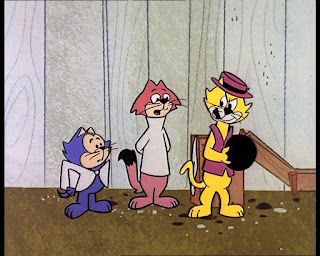The Hanna-Barbera style of animation (better known as "Limited Animation") has always been attractive to me, even when I didn't necessarily know what I was looking at. Since learning about animation processes and techniques, I've realised that every scene in this style isn't just about the animation - there's problem solving being done. Finding the most efficient way to create a scene with a reduced time frame is an integral part of this method.
 Hanna-Barbera operated in a time when Disney and Looney Tunes were kings of the animation industry. After success with theatrical Tom and Jerry shorts, the studio looked to make animation for television. However, the processes being employed by Disney and even Warner Brothers were far too costly and time consuming for the medium to be a success on TV.
Hanna-Barbera operated in a time when Disney and Looney Tunes were kings of the animation industry. After success with theatrical Tom and Jerry shorts, the studio looked to make animation for television. However, the processes being employed by Disney and even Warner Brothers were far too costly and time consuming for the medium to be a success on TV.From studying different Hanna-Barbera series, I observed many of the "tricks" used to create entertaining content with efficient production. This style had a massive impact on the animation industry throughout the 20" century, particularly with the rise of animation made for television. What made this style so attractive to the studios was the use of fewer drawings and a reduced frame rate - resulting in snappier animation but more importantly less cost and time spent. These factors are intrinsically linked in animation, especially for TV.
Limited animation relies heavily on sound, particularly dialogue, to carry the plot - it is an effective way to produce animation cheaply but keeps it entertaining for the audience. The animators would frequently re-use assets i.e. backdrops, walk/run cycles and character poses, minimizing the need to create new elements for each frame. Additionally, they would extend the duration of key poses, reducing the necessity for complex in-between movements.
My favourite examples of limited animation are from shows like The Flintstones and Top Cat, both highly entertaining cartoons in their own right. From studying these shows, it's apparent there's not an extraordinary amount of animation taking place. There tends to be mouth/head movements & when they walk their legs move but the upper half is usually pretty rigid.
Many times the animation on screen is limited to only two layers, for example a head & mouth layer, or as few as one layer. In some scenes, if a character is having an internal thought there may not be any animation at all!
What you’ll notice with Hanna-Barbera is the characters arms and legs tend to have specific cut off points to hide the edge of the appendage, which would be on its own layer. I believe this is why many Hanna Barbera characters had ties, necklaces, collars and high shirt lines. The key asset that Hanna-Barbera had at its disposal was its music, voice acting and scripts - without great acting and great writing, the animation (or lackthereof) would probably have stood out more. Instead of relying heavily on motion, limited animation emphasizes strong dialogue and compelling soundtracks to make up for fewer frames, keeping the audience engaged through storytelling and audio elements.
I would also be remiss if I didn't acknowledge Japanese animation. known in the West as Anime, which uses its own unique style of limited animation. Characters in anime often remain static whilst only the mouth layer moves, and even simple head and body movements are often limited. As with the western style, the episodes are usually carried by the strong voice performances and writing - using limited frames, animation cycles and the occasional blink. I may do a deep dive on anime itself in future as it is a rich topic in itself.











No comments:
Post a Comment